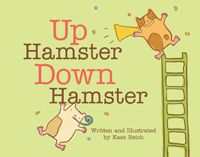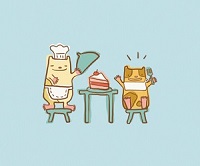| ________________
CM . . .
. Volume XXI Number . . . .June 19, 2015
Design wise, each pair of facing pages deals with one set of opposites. Most of the opposites are words that one would expect the intended audience to have likely encountered, opposites such as the title’s up/down, day/night or happy/sad. Each opposite word is followed by the word “hamster” as in IN hamster/OUT hamster. Where this offering falters somewhat is in Reich’s illustrations of some of the contrasting pairs. There are a number of instances in which her illustrations quite clearly capture the “meanings” of the opposites with one example being IN hamster and OUT hamster in which two hamsters are initially seen swimming “in” a fish bowl while the facing page’s illustration shows them “out” of the bowl and wrapped in towels. In HAPPY hamster/SAD hamster, four hamsters are shown exuberantly celebrating something on one page while one of the four hamsters is portrayed alone on the second page. The floral garland the celebratory hamster had been wearing is now on the ground, with portions missing. The big smile that had been on the hamster’s “happy” face has been replaced by a downcast “sad” look. However, sometimes Reich demands much of her young “readers” as is the case with FAST hamster/SLOW hamster. For “fast”, Reich shows a single hamster in a red wagon that is being pulled by another hamster. Reich places three motion or movement lines to indicate that the wagon is moving quickly. Adults will recognize the convention of the motion lines, but the book's young audience will need to be taught it. On the “slow” page, four more hamsters have joined the original hamster aboard the wagon, with the pulling hamster now facing the wagon and straining to keep it moving. Interpreting the puller’s changed posture may again need to be explained to a young audience. The board book’s weakest pairing of words and illustrations is SHHH hamster/SHOUT hamster. The SHHH hamster illustration shows three seated hamsters, with one knitting and two reading books. One of the reading hamsters is seated under a hanging lamp. On the SHOUT hamster page, the hamster who had been seated beneath the lamp is now swinging from it in Tarzan-like fashion while shouting through a megaphone, action lines being used to indicate sound. The other two hamsters, apparently startled by the noise, have tossed their knitting and book into the air. Parents and other adults sharing this book with young children should not be surprised if children substitute their own words for the author’s words. The pair of illustrations accompanying YES hamster/NO hamster shows an apron and chef’s hat-wearing hamster first revealing a piece of cake to a bib-clad hamster seated at a table, a fork in the hamster’s hand. In the second illustration, the cake has been replaced by a bowl of green “something” with a fly hovering over it. The once held fork is now on the floor, and the big smiles connected to the cake’s appearance have been replaced by grimaces. HAPPY/SAD? LOST hamster/FOUND hamster initially sees one hamster seemingly hiding behind a potted plant while two other hamsters, one holding a magnifying glass and the other with binoculars around its neck, stand next to the plant. In FOUND hamster, the hamster pops out from behind the plant while the other two hamsters register surprise. I suspect many children will connect these pages with a game of hide-and-go-seek. Following DAY hamster/NIGHT hamster, the book’s penultimate pair of facing pages does not provide a tenth set of opposites. Instead, it reveals the eight hamsters who have appeared throughout the book tucked into four bunk beds, a subtle reminder that the book can be used prior to a child’s nap/sleep time. The final page pairing presents the eight hamsters holding hands and waving farewell to the book’s readers/viewers. Overall, Up Hamster Down Hamster is a worthy purchase for libraries serving this preschool audience. Parents should also consider it as a home purchase. Recommended.
Dave Jenkinson, CM’s editor, lives in Winnipeg, MB.
To comment on this title or this review, send mail to cm@umanitoba.ca.
Copyright © the Manitoba Library Association. Reproduction for personal use is permitted only if this copyright notice is maintained. Any
other reproduction is prohibited without permission.
CM Home |
Next Review |
(Table of Contents for This Issue - June 19, 2015.)
| Back Issues | Search | CM Archive
| Profiles Archive |

 Very young children first met this hamster horde (the collective name for a group of hamsters) in
Very young children first met this hamster horde (the collective name for a group of hamsters) in